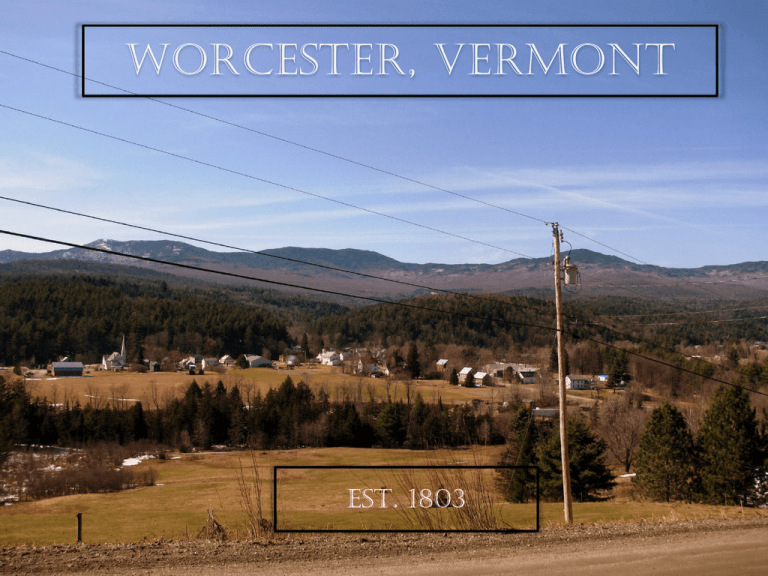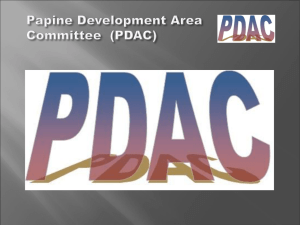Worcester, Vermont
advertisement

Worcester, Vermont EST. 1803 Town History Records of the town has been kept in excellent condition since the two was first settled. The only mystery that still remains is when the exact date that the town was first settled because a fire destroyed the Town’s early records. Governor Ben Wentworth of New Hampshire charted Worcester, VT on June 8th 1763. sixty-four people originally owned the seventy-one shares of land that they chose to give names to. The town at this time was six miles square and consisted of twenty three thousand forty acres. John Ridlan and George Martin were the first settlers in Worcester in 1797 and the town wasn’t immediately settled into at first. By 1800 the population had increased from the two families that were living there to twenty-five people and then again increased in 1810 to 41. The town didn’t increase in population until 1820 mostly because of the “Year Without a Summer.” Year without a Summer was caused by a volcanic eruption that altered the summer weather causing a frost. Duncan Young was the first town clerk, he helped organize the town in 1803 and the town records were kept in Worcester until the 1816 fire and then they were moved to Burlington. After 1816 the history is easier to connect events because the records were clearly kept from there on out. The first recorded town meeting occurred on March 14th, 1821 at Amasa Brown’s house. Many people were elected to different committees and boards. The first recorded marriage was between Oliver Watson and Esther Brown in 1817. Reverend Harvey Gurnsey built Worcester’s first Methodist Church in 1848 and then became the preacher two years later. In 1888 a new church was constructed with seating for 250 people because the population kept growing. A few months later he organized the churches Sunday School and forty students attended. This church occupied where the current town hall is until it burned in 1907, which left the site to remain empty until 1912 when the town hall was constructed. The town relied a lot on the agricultural business that supported the town folk. Out of all the dairy farms and hundreds of other small agricultural operations, only one dairy farm and a handful of small agricultural businesses remain. Timeline • • • • • • • • • • • • • • • • • • • • 1763 – Worcester, Vermont was chartered by the governor of New Hampshire, Ben Wentworth. 1797- The first settlement was made by John Ridlan and George Martin 1800 – Population increased to 25 people. 1810 – Population increased again to 41 people. 1816 – “Year Without a Summer” 1820-1830 – Population increased to 400 people. 1803 – Duncan Young, the first town clerk, organized the Town 1816 – Earliest records of the town was lost in a fire. 1817 – First recorded marriage was recorded in the new records. The marriage of Oliver Watson and Esther Brown. 1821 – The first recorded town meeting took place at Amasa Brown’s house. 1848 – Reverend Harvey Gurney built the first Methodist Church. 1888 – A new church was constructed and Sunday school began. 1893 – The school house was built 1907 – The new church burnt down. 1912 – The Town hall was built. 1915 – The new Methodist church was built 1925 – The Methodist Church was moved from where it originally sat to where it currently sits. 1952 – The steeple on the Church was struck by lightening. 1963 – The ranch style home was built by the family that occupied it until 1972. 1978 – LBJ’s Grocery was built. Town Map Contents: School House Calais Road Town Hall 20 Worcester Village Road Methodist Church 35 Worcester Village Rd Ranch Style Home 441 Elmore Rd LBJ’s Grocery 44 Worcester Village Road The Old School House This is the old School house in Worcester, VT; it was built in 1893. As you see here that there are two entrances to the school. It has a very symmetrical style about it. Everything appears to come in twos. This style is similar to Queen and Shingle style. You can see on the third level that the siding become shingles which is a stylistic feature of the shingle style. Then, it has the clean look of the Queen Anne style being that there is a varied use of wood and as you’ll see in the next slide stone work foundation. The Old School House sits exactly in the place where it was built unlike, the Methodist church that was moved. Old School House Pictures Original Stone Foundation Porch Detail Old School House Pictures Porch lattice detail Original Windows Town Hall The town hall was built in 1912. It held it’s first town meeting in 1915 after the construction was completed. It sits where the second Methodist church would have sat until it burnt down. The town hall is no longer used for town meetings because the population of the town simply would not hold the amount of people. Downstairs of the town hall houses bathrooms, an open meeting room, a coat room, storage closet, and a full kitchen (because it is now used as a soup kitchen on Wednesdays). The upstairs however houses a stage and plenty of floor space. This was the original space that was used for the meetings, town get together, festivities, and dances. The town hall was recently updated to bring the building up to code so that it could be used in the future. What was added was an elevator, new set of steps and a handicap ramp which also includes that the electrical wiring that was all original until this past fall. Town Hall Pictures Meeting Room (Downstairs) Original Flooring (Downstairs) Town Hall Pictures Upstairs gathering area Original Staircase Town Hall Pictures Original Door Handles Original Wallpaper, Flooring, and Baseboard Methodist Church The Methodist church was built in a different location originally than where it sits today. It was built in 1915 a few years after the town hall was built. It was originally built next to Amasa’s farm on Elmore Road. Moving the church in 1925 was a challenge the technology to move something of this scale was just starting to come out. Slowly they took the steeple apart, separated the roof from the building and soon moved the larger part of the church by taking it down wall by wall. It took a year to reconstruct it where it currently sits. A new steeple since then has been built because it was struck by lightening. The church still uses a rock foundation which is found at the old school house too. The style of this building is the same as the old school house being that it’s a mixture of Queen Anne and shingle. The two styles together made it easier for the buildings to blend together. The church also doesn’t have any stained glass. Methodist Church Pictures Bell Pull Looking towards the apse Methodist Church Pictures Original Hardware The Original Organ Methodist Church Pictures Original Chandelier Window Detail Ranch Style Home Someone in Worcester, Vermont doesn’t need to acquire a zoning permit and most of the houses were built by the owners. This house was built by a few members of our family. It’s a ranch style house. It’s basically one level on a full basement. It included a wood furnace at the time, until this wasn’t convent for my grandmother. It’s been adapted for the occupants. Instead of being in a city where the sewer and water comes from the ground it is run on an old well pump system which still to this day works. The roof was modified so that the snow and icicles wouldn’t be an issue with weight. It was also built with a two bay-garage (which is not in any of the pictures). The big picture windows and glass door were put in place for the view of the mountains. Ranch Style Home Pictures Heated Hearth Fireplace Entry way to the living room Ranch Style Home Pictures Backside to the house Notice the symmetry Original Carpet (ignore the pets) Small Town Store This small store was built based on a ranch style home so that it would blend better with the surrounding homes. The store originally took a major role in selling the farms food, milk, etc. Recently as the economy has changed and demands have changed the need for other supplies in the town has shaped the building of the recent gas pumps and the additional space for the selling of plows for the winter. The store even added a deli recently and delivery services for the town people of Worcester, Vermont. Small Town Store The Entry way into the store Small Town Store View Towards Deli View from front entrance down the aisles Credits Worcester Historical Society o o Betty White Judy Knapp Town Clerk o Sandra Ferver Ranch House o Betty Campbell Worcester United Methodist Church o Pastor Jerry LBJ’s Grocery Worcester’s Early History o Publication I – Early history of Worcester, Vermont by Charles C. Abbot o Vermont Historical Gazetteer, vol. 4, part 2 by Carrie Elizabeth Hemenway





